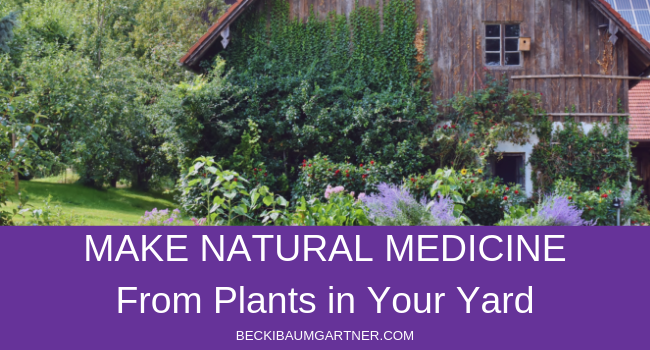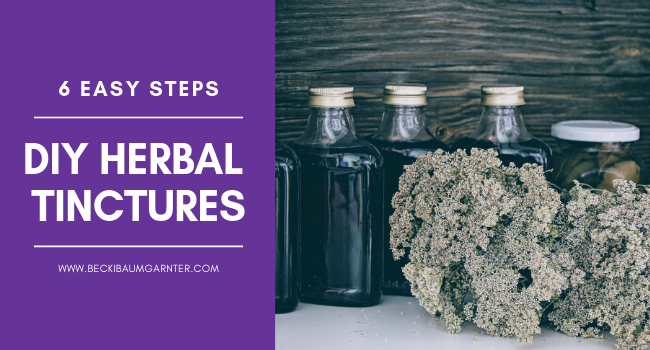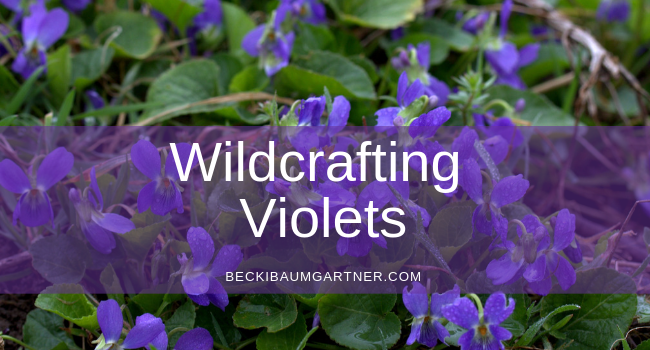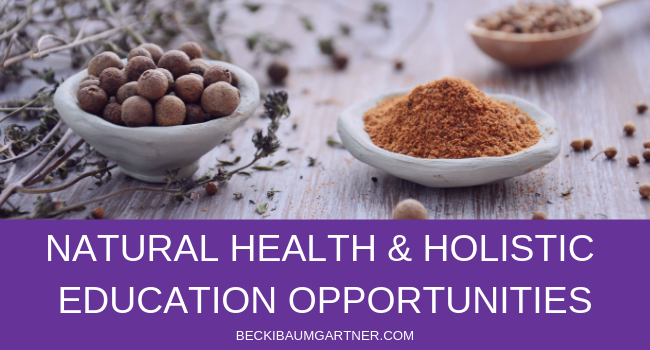Yes, you can quickly and easily make herbal medicine from plants found in your yard!
In fact, it’s SO easy, it’s called “Simpling”!
What is Simpling?
Simpling is the practice of using single herbs alone.
In medieval times in Europe, the art cultivating and using herbs was called “Simpling” and the herbs themselves were named “Simples”.
Simpling can be very effective, even though some herbalists have a condescending attitude towards the practice.
(Simpling is more often associated with folk herbalism rather than academic or monastic herbalism.)
The Three Main Principles of Simpling
#1 Use Herbs That Grow Nearby
The type of illness common in a particular area is somewhat dependent on the environment of a particular area.
Likewise, herbs growing naturally in the area take on the characteristics of their environment. This makes the naturally-growing herbs perfect for treating the ailments associated with the climate and environmental conditions of a particular area. One of the easiest ways to begin using herbs is to learn about the plants growing in or around your own backyard. A single herb can treat many different conditions.
#2 Use Mild Herbs
Mild herbs are safe to take as often as desired and will gently affect all body systems.
This will help healing in many areas at the same time, and heal many minor afflictions.
You may be surprised at how many of your minor afflictions are intertwined!
#3 Use Often or Use Large Doses
Since you are using very mild herbs, only a large dose will have the power to overcome most illnesses.
A great way to get a large dose is to use your wildcrafted herb to make a herbal tea. Drink the tee freely.
Or, you could make a homemade tincture. Tinctures are generally ingested in doses of one teaspoon three times daily (Tierra, The Way of Herbs, 1998.)
Easy-to-Find Herbs Perfect for Simpling
CALENDULA (Marigold, Calendula Officinalis, Calendula Marigold)
Parts Used Medicinally: Flower Heads
Systems Affected: Liver, Heart, Lungs
Externally calendula is used as an oil, in a salve or as a poultice to treat burns, stop bleeding, sooth pain and promote healing of wounds and burns. It heals the body by promoting cell repair (vulnerary) and keeps the infection from occurring in injuries (antiseptic).
It is most often used for bruises, burns, skin ulcers, and sores. A poultice of the petals applied topically is an excellent treatment for shingles. A drop or two of calendula oil placed in the ear with a wad of cotton will treat earaches.
Internally calendula is used to treat fevers, ulcers, menstrual cramps, and eruptive skin diseases like measles. It is also used to treat gastrointestinal upsets such as ulcers, cramps, indigestion, and diarrhea.
Calendula is used as a vulnerary, emmenagogue, diaphoretic, alterative, and astringent. Calendula should not be taken internally during pregnancy.
CHRYSANTHEMUM (Mum, Chrysanthemum Morrifolium, Chu Hua)
Parts Used Medicinally: Flowers
Systems Affected: Blood, nerves, Digestion, Liver
Chrysanthemum is a very popular herb used in China to treat Yang ailments. It is used to reduce inflammation, abscesses, and boils. Yellow chrysanthemum flowers are used internally to reduce inflammation and pneumonia and to treat fevers, headaches, and dizziness. It is used as an alterative, antipyretic, and carminative.
DANDELION (Taraxacum Officinale)
Edible: Young dandelion greens can be eaten raw and fresh in salads or can be steamed as a potherb. The greens can also be marinated in oil and vinegar; prepared in this way the loose most of their bitterness. Another way to prepare the leaves is to steam them, then marinate them overnight in Italian dressing and honey. The young, tender roots can be added to stir frys, soups and casseroles. The flowers are used to make wine.
Parts Used Medicinally: Whole Plant
Systems Affected: Liver, Spleen, Stomach, Kidney, Bladder
Dandelion is an alterative, cholagogue, diuretic, stomachic, aperient, tonic, and digestive bitter. It is used for liver problems, urinary tract infections, skin eruptions, stomach pains. Breast cancer, and beverage. The main benefit of dandelion is its effect on the liver. It helps clear obstructions and stimulate the liver to detoxify the blood. Therefore, dandelion is also often used as a blood purifying herb.
Dandelion root is useful for clearing obstructions from the bladder, kidneys, gallbladder, pancreas and spleen. It also soothes stomach aches, and calms stomach and intestinal issues. Dandelion root tea has been used in the past to cure hepatitis. Dandelion leaf tea is an excellent diuretic and can be taken for fluid retention, cystitis, nephritis, hepatitis and weight loss. Dandelion root is commonly used for hypoglycemia.
ECHINACEA (Echinacea Agustifolia, Echinacea Purpurea, Echinacea Pallida, Coneflower, Purple Coneflower, Snakeroot, Prairie Coneflower)
Parts
Used Medicinally: Roots, Leaves, Flowers
Systems Affected: Lungs, Stomach, Liver
Echinacea can be used for all acute inflammatory conditions and is generally mild enough that even large does generally do not cause side effects. It can be used internally to treat inflammatory conditons such as boils, skin eruptions, pussy sores, venemous bites, poison oak, poison ivy, septicemia, syphilis, gonorrhea, viral infections, and bacterial infections. Echinacea has been in constant use in Germany since the 1930’s for chronic conditions such as arthritic diseases, certain cancers, viral diseases, and possible treatment for AIDS. Echinacea is also used as an immune system booster and works by increasing macrophage T-cell activity. This raises the body’s resistance to colds, flus, and many other illnesses. It can be used to prevent as well as to cure. Echniacea is very strong and potent, but is also 100% safe for all people–children and elderly included.
HONEYSUCKLE (Honeysuckle, Japanese Honeysuckle, Yin Hua, Lonicera Japonica)
Parts Used Medicinally: Flowers
Systems Affected: Blood, Liver (Clears Heat)
The Chinese use the honeysuckle as a detoxifier and is utilized for all acute infectious and inflammatory conditions. Externally it is an excellent remedy for poison ivy, poison oak, and other rashes. Internally it can be used alone or with chrysanthemum flowers to treat acute flus, fevers, and other conditions of this nature. Honeysuckle is not intended for extended usage and therefore is not considered medicine for chronic conditions.
MULBERRY (Morus Alba, White Mulberry)
Parts Used Medicinally: Fruit, Leaves, Twigs, Root Bark.
Systems Affected by Fruit: Kidney, ADrenals, Liver, Heart
Systems Affected by Leaves: Lungs, Liver
Systems Affected by Twigs: Liver
Systems Affected by Root Bark: Lungs
Mulberry fruit is a Yin and blood tonic which is used for symptoms of dizziness, anemia, hypersensitivity, nervousness, tinnitus (caused by weakness), hypertension and dry constipation. (Contraindicated for those with a tendency towards constipation.
Mulberry root bark is used as an expectorant and antitussive and mostly used to clear lung inflammation. It is a cough supressant, expectorant, and reduces hypertension. (Contraindicated for those with coughs caused by coldness.)
Mulberry leaf is a diaphoretic which is calming and cooling and is used for feverish colds, sore throat, headaches, acute conjunctivitis, and vomiting of blood. (Contraindicated for those with low vital energy and cold, weak condition of the lungs.)
Mulberry branch is used to treat arthritic and rheumatic problems and hypertension and is an excellent antirheumatic and antispasmodic.
RED CLOVER (Trifolium Pratense)
Parts Used Medicinally: Blossoms, Leaves
Systems Affected: Blood, Liver, Heart, Lungs
Red Clover is an alterative, antispasmodic, expectorant, and antitumor. The blossoms are used in the treatment of cancer and tumors, skin diseases, fevers, colds, and coughs. It has some mild blood thinning properties due to its coumarins and is often used for many chronic degenerative complaints. Red clover blossoms have been successfully used for skin complaints, eruptions, psoriasis, and eczema. The blossoms have antispasmodic and expectorant properties and are very useful in treating coughs, colds, and other issues involving congestion. To treat cancer and tumors, it is recommended to combine equal parts of red clover blossoms, chaparral, poke root, burdock root, dandelion root, stillinga root, Oregon grape or barberry root, echinacea root, sasparilla root, sassafrass and devil’s club.
Red clover leaves and blossoms are considered one of the best respiratory tonics and detoxificaton herbs. It is especially useful in treating coughs, colds and bronchitis.
Note: Red clover is contraindicated for hemophiliacs or people with “thin” blood, as the herb may make this condition worse.
ROSEMARY (Rosmarinus Officinalis)
Parts Used Medicinally: Leaves
Systems Affected: Liver, Stomach, Spleen, Pancreas
Rosemary is an antipyretic, anti-inflammatory, stomachic, nervine, diaphoretic, astringent, anodyne, and antiseptic. It is used to treat headaches, indigestion, colds, inflammation of the joints, and as a tonic for scalp and hair. Rosemary is believed to be as effective as aspirin for headaches and inflammatory arthritic pains. It has been used to treat stomach aches, headaches, colds, and to strengthen the hair. Rosemary is good for circulation and has a tonic effect on the nervous system. It has been reported to reduce high blood pressure and strengthen the heart.
Sources:
- Gladstar, R. (2008). Rosemary Gladstar’s Herbal Recipes for Vibrant Health. North Adams, MA: Storey Publishing.
- Tierra, M. (1998). The Way of Herbs. New York: Pocket Books.






